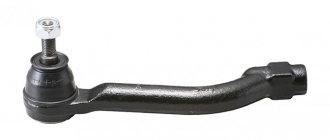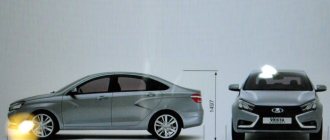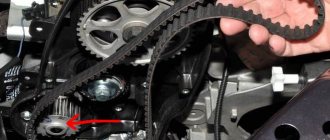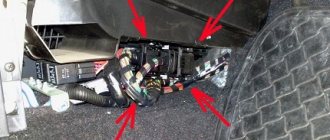On April 19, 1970, the first Zhiguli cars rolled off the main assembly line of the Volzhsky Automobile Plant. It was a VAZ-2101 model, popularly nicknamed “kopeyka”. After it there were five more models from the “classic” series, one Oka, a dozen Ladas. All these cars are not twins at all. Each VAZ has significant differences that are worth clearly seeing.
- Oka (1987—2008)
- LADA Samara family
- Family "ten"
VAZ-2110 (1995–2010)
- VAZ-2111 (1997–2010)
- VAZ-2112 (1998–2008)
- VAZ-1117 (2004–2018)
Classic Lada
The classic Zhiguli family consists of seven models of rear-wheel drive small class cars. There are two body types in the lineup - a four-door sedan and a five-door station wagon. All models are distinguished by a laconic design - now the appearance of Ladas may seem rustic, but for their time classic VAZs were quite stylish Soviet cars.
This infographic shows how the appearance of AvtoVAZ cars has changed from 1970 to 2022
VAZ-2101 (1970–1988) - the foreign public knew the model as LADA-120. It is a four-door sedan. The “penny” took away all external features from its Italian counterpart:
- cubic body shape (still with rounded corners, while subsequent models will become more “chopped”);
- a simple “facade” with a rectangular grille and a round pair of headlights;
- high roof line;
- rounded wheel arches;
- a laconic “rear” with vertically oriented lights and a small trunk lid.
The prototype for the first VAZ was the Fiat 124 (and quite legally, since an agreement was signed between the owner of the Italian concern and the Soviet Vneshtorg)
VAZ-2102 (1971–1986) - the five-door station wagon turned out to be spacious. In addition to the changed body type, the “two” is distinguished from the “kopek” by the license plate located on the fifth door and vertical rear lights.
The trunk of the VAZ-2102 could accommodate a lot of luggage (therefore, the car was the dream of every Soviet summer resident, fisherman, hunter and tourist)
VAZ-2103 (1972–1984) - the third model of the Lada (Lada 1500 in the export version) was launched from the assembly line in the same year as the “two”. The three-ruble note can be easily distinguished from the VAZ-2102, since they have different body types. But the large radiator grille with twin headlights “sitting” directly on it will help distinguish the VAZ-2103 from the previous sedan (“penny”).
Over 12 years, 1,304,899 of these Zhiguli “three rubles” were produced
VAZ-2104 (1984–2012) - station wagon, known in the West as Kalinka. The main difference from its predecessors is not round, but rectangular headlights. The lines of the body are more chopped (the roundings at the corners have become less pronounced than, for example, the “kopek”).
This five-door car demonstrates the classic Zhiguli design; The VAZ-2106 is larger than the “two” - it is 42 cm higher, and the luggage compartment is 112 cm longer
If the VAZ-2104 is the first domestic station wagon with rectangular headlights, then the VAZ-2105 is the first sedan with a similar form of optics. The body of the “five” is distinguished by its greater angularity. On the side there are wings with cut contours. The roof does not have a hint of rounding, the hood and luggage compartment are longer than those of a “kopek” or “troika”.
Export cars were called LADA-2105 Clasico; Soviet car enthusiasts nicknamed the car “stool”; “five” was liked by Soviet citizens who did not want to buy a station wagon, but wanted to have a car with a spacious trunk
VAZ-2106 (1976–2006) - popularly nicknamed the “Lada Six”; for foreign buyers the name Lada 1600 was used - a rear-wheel drive four-door sedan. A special feature of the VAZ-2106 is a round pair of headlights, “planted” not on the radiator grille, but in black plastic rectangles.
The VAZ-2106 became the most purchased car of the seventies and eighties in the USSR (in total, over 4.3 million “sixes” were produced and sold, while “threes” produced 1.3 million copies, and “fives” - 1.8 million)
VAZ-2107 (1982–2012) was made in accordance with the automotive trends of the eighties. At that time, angular, even slightly rough shapes, an abundance of chrome parts, and protruding parts (like the radiator grille, which began to protrude from the level of the hood) were fashionable. Like the VAZ-2106, the headlights are set in plastic rectangles (the difference is that the “six” has round front optics, while the “seven” has rectangular ones).
American automobile journalist Jeremy Clarkson, reviewing the VAZ-2107, called the car “a car for rude men who cannot tolerate anything feminine”
Selection of carburetor for VAZ 2101-2107
An engine is a complex mechanism that is sensitive to the quality of the prepared fuel-air mixture. The air-to-gasoline ratio greatly affects speed characteristics. The more air, the worse the car accelerates and the fuel consumption increases. An excess of the latter leads to the same result. The resulting soot from unburned gasoline covers all engine parts, worsening heat transfer and causing the engine to “boil.” Therefore, the carburetor is selected according to the engine size:
- "Ozone 2105" is intended for engines with a volume of 1200, 1300 cm3.
- "Ozone 2107" - 1500 and 1600 cm3.
- "Solex 21053" - 1500, 1600 cm3.
- "Solex 21073" - 1600, 1700 cm3.
But it’s better to entrust its selection and configuration to a specialist because it will be easier, faster and cheaper than doing everything yourself.
VAZ-2105 and 2107 are largely identical cars, differing from each other in body parts, an improved instrument panel and an improved interior.
Oka (1987—2008)
VAZ-111 (Lada Oka) is a Russian ultra-small class car. About 700 thousand models were rolled off the assembly line. The body type is a three-door hatchback. In an effort to reduce the size of the car, the developers sacrificed the harmonious appearance, which is why Oka was popularly nicknamed “Cheburashka”. Characteristic appearance features:
- miniature body;
- angular lines;
- rectangular optics;
- bumper made of unpainted plastic;
- shortened overhangs;
- short wheel arches;
- roof pillars too thin;
- large glass area.
Oka is 3200 mm long, 1420 mm wide, 1400 mm high
LADA Samara family
In 1984, the Volzhsky Automobile Plant decided to carry out a complete restyling of its VAZs and released the Lada Samara (aka VAZ-2108). In 1987, another model of this family was presented to the public - the VAZ-2109. The differences between the Samara and the classic Zhiguli were colossal, which divided Soviet citizens: some were outraged by the changed appearance of VAZs, others praised the manufacturers for innovations that separated domestic cars from the progenitor Fiat 124.
Initially, in the domestic market this line of VAZs was called “Sputnik”, and the name Lada Samara was used only for export cars
VAZ-2108 (1984–2003) - the three-door hatchback VAZ-2108 was popularly nicknamed “chisel” and “crocodile” for its elongated, narrowed front part. The car is spacious, as it was intended to be used as a family car. The body of the Samara is more rigid and, accordingly, safer than the “classics”. The rear seats are made with children in mind, and the trunk is spacious.
For the first time in the VAZ model range, VAZ-2108 began to be painted with metallized enamels in mass production
The VAZ-2109 (1987–2004) differs from the VAZ-2108 in that it is a five-door rather than a three-door hatchback. There are no other significant differences in appearance.
The width and length of the VAZ-2109 are the same as those of the VAZ-2108, and the height is an insignificant 4 cm greater
Quick comparison table
Despite the many years that have passed since the start of production, both sedan models remain in demand among Russian consumers. You can often find both cars on the secondary market. And to make it easier for potential buyers to make a choice, we will briefly list once again how the VAZ 05 sedan differs from the VAZ 07 model.
| 2105 | 2107 | |
| model | simple, standard | improved, used to be luxury |
| radiator screen | regular plastic | imitation chrome coating |
| relief decoration | on the trunk | on the hood |
| headlights | ordinary | improved |
| bumper | aluminum | steel |
| seats | ordinary | anatomical |
| heating system | through the head duct | through the radiator |
| fuel consumption | more | less |
| acceleration to 100 km/h | faster | a little slower |
| maximum speed | less | more |
| ease of control | low | a bit better |
| price | low on the secondary market | a bit higher |
Family "ten"
In 1983, the design of a sedan based on the VAZ-2108 hatchback began. The project received the code name “family of ten”. The VAZ-2110 was released first, then the VAZ-2111 and VAZ-2112 station wagons went on sale.
VAZ-2110 (1995–2010)
VAZ-2110 - four-door front-wheel drive sedan
VAZ-2010 (LADA 110) is a four-door front-wheel drive sedan. It was distinguished by its “biodesign”, fashionable for the mid-1990s, with smooth outlines and maximum glazing area.
The VAZ-2110 has fairly large rear wings, but the car does not seem heavy due to the reduced size of the bumper
VAZ-2111 (1997–2010)
VAZ-2111 is a station wagon that is valued for its spacious luggage compartment with a wide opening.
In the front part, this model completely replicates the VAZ-2110.
The VAZ-2111 five-door sedan has a spacious trunk
VAZ-2112 (1998–2008)
VAZ-2112 (aka LADA 112 Coupe) - this hatchback is a symbiosis of the VAZ-2110 and 2111
It's just as roomy as a station wagon, but the model's appearance is lightened by the sharp transition from the roof to the tailgate. There are no corners, all lines are very smooth.
The body length of the VAZ 2112 is less than that of the VAZ-2110, but the capacity is greater (due to the increased luggage compartment)
Interior
The interior of the car generally follows the contours of the body - it is just as angular, which gives it a progressive look in comparison with the smooth lines of the VAZ-2101 and 2103. There are few differences, as in the appearance:
1. Instrument panel.
The instrument panel in the Lada 2107 is distinguished by a convenient location for the radio and additional instruments. They include a digital clock, indicator lamps (brake pad wear, heated rear window, whether the driver is wearing a seat belt), and a cigarette lighter.
The switches located around the instrument cluster in 2105 are located in front of the gearshift lever in 2107.
2. Instrument cluster.
The instrument cluster in the “five” provides the driver with only basic information about the current state of the car: speed, coolant temperature, amount of fuel, voltage in the on-board network, total mileage.
The instrument cluster in the “seven” is additionally equipped with an econometer, a tachometer and a daily mileage counter.
3. Seats.
In the fifth Lada model, seats from 2103 were installed with a slight modification - they were equipped with a headrest. The seventh model was equipped with anatomical seats.
LADA Kalina
Kalina are front-wheel drive cars of the “small class II group” (segment “B” by European standards). The family includes a sedan, a five-door hatchback and a station wagon. These three VAZs became the first AvtoVAZ “projects” developed using computer technology.
VAZ-1117 (2004–2018)
VAZ-1117 or LADA Kalina 1 - five-door station wagon
It has a narrowed front and a powerful rear with a large trunk lid. But the transitions between different parts of the car are smooth, so the car as a whole looks harmonious.
Lada Kalina has a shorter length and width than Lada Samara, therefore it has better maneuverability and is more suitable for driving on busy city roads
VAZ-1118 (2004–2013)
Lada Kalina Sedan seems small, but this is an optical illusion, since the dimensions are identical to 2117
VAZ-1118 (LADA Kalina sedan) seems smaller than a sedan, but this is an optical illusion, since their dimensions are the same. The front end can be called aggressive due to its predatory tapering headlights and narrow radiator grille. But the bumper is very neat, which makes the car light.
The rear of this model looks inconspicuous, as the only thing that can be distinguished from it is the massive trunk lid
VAZ-1119 (2006–2013)
The body of the VAZ-2119 is designed in the same style as that of the VAZ-1117
VAZ-1119 or LADA Kalina hatchback - the body of this model is designed in the same style as the VAZ-1117. The bumper is round in shape, the trunk lid is small and has a maximum glass area. The rear lights are arranged vertically and are more elongated in shape than those of the station wagon and sedan.
This model seems to be the neatest among its brothers in the LADA Kalina family, although its length is only 190 mm shorter, and there are no differences at all in width and height
LADA Granta
Lada Granta is a domestic front-wheel drive car, developed on the basis of LADA Kalina. The developers were given the goal of making a car that would be as close as possible to the Kalina in technical parameters and appearance, but to reduce its cost. The desire to reduce the cost undoubtedly affected the appearance of the car.
LADA Granta sedan differs from Kalina in how the car looks from the front. The front part features a stylish “pattern” of headlights, radiator grilles, license plate and logo sign. These elements are placed on a black backing in the shape of the letter X. From the side and rear, Granta repeats the LADA Kalina sedan.
Granta's trademark is the black X in the front of the car - it houses slanted headlights, a large brand logo and chrome “boomerangs” that visually unite the radiator and lower grilles
In 2014, production of Lada Granta Liftback began. Like the sedan, the liftback has an X-shaped design at the front. In addition, the model is distinguished by a convex roof, smoothly turning into a miniature rear part.
At the rear of the liftback are small horizontally elongated lights, a large fifth door and a bumper with a black insert stylized as a diffuser.
LADA Granta sport (2018 to this day) is a front-wheel drive sedan of the “subcompact” category. It is not particularly spacious, nor is the liftback. During its development, the emphasis was placed on modern dynamic design, aimed at a youth audience. A voluminous bumper, a wing on the trunk lid and massive 16-inch wheels with a large number of small spokes give it a sporty look.
LADA Granta sport (2018 to this day) - front-wheel drive sedan of the “subcompact” category
Let's sum it up
Those who have had a driver's license for a long time know about the differences between the VAZ 2107 and 2105. But beginners often have doubts about the choice, since distinguishing one car from another is problematic. And there is no particular difference in technical and functional equipment. The main differences relate to the external features of the “seven” and its comfort in terms of landing and control.
The VAZ manufacturer itself at one time considered the differences between the standard and luxury models significant. But now they have almost leveled out, both models are sold as budget ones.
VAZ 07 and 05 sedans are among the cheapest cars on the Russian secondary market, but potential buyers should understand that most of these models are many years old. This means that the quality of assembly and functional elements does not meet modern standards; many parts are worn out and require replacement. No matter which of the presented cars you choose, you cannot hope for a 100% safe and comfortable ride.
If desired, you can do tuning and update the car outside and inside. But this will require additional cash injections, and considerable ones. In this case, a more acceptable option is to purchase a modern car in the appropriate price category.
Lada Largus
In 2011, AvtoVAZ presented to the public the first model from the Largus family. It was a C-class car, the prototype for which was the Romanian Dacia Logan MCV 2006. The line includes a passenger station wagon and a van.
Lada Largus R90 (2012 to this day) is a passenger station wagon in 5- and 7-seater versions. Its design is simple, devoid of any decorations.
Many people think that Largus looks awkward, but the developers decided to sacrifice the lightness of its appearance for the sake of spaciousness and ease of use of the passenger part of the car.
Largus F90 (2012 to this day) is the same R90. Only instead of the passenger part there is a cargo compartment, which has blank rear and side panels on the outside. The rear hinged doors can be locked in three positions. The side doors provide a wide opening angle, so that unloading can also be done through them.
The rear of the van and the doors are designed to make loading and unloading even large items easy
Lada XRAY (2015 to this day)
LADA XRAY is a compact hatchback made in the style of an SUV (a sports-utilitarian car used daily and allowing it to accommodate a lot of cargo). The front bumper of the car is raised and has an X-shaped black pattern like the Lada Granta. A relief (stamping) appeared on the sidewalls, giving the car a dynamic appearance.
Appearance Lada XRAY has a rather aggressive look
The first AvtoVAZ car was rolled off the assembly line in 1970. Since then, the plant's designers have not been idle and are constantly coming up with new variations, focusing on the changing needs of society. The ancestor of the VAZ, the “kopek” has absolutely nothing in common with the modern Ladas Largus, XRAY, Granta.
Which one to choose?
When choosing a VAZ model, focus on your personal needs. The difference in price on the secondary market is insignificant, but the “seven” is somewhat more comfortable than the “five,” especially with regard to the seats, steering wheel and dashboard. And externally, the “seven” looks more stylish and modern.
It follows from this that the 2107 sedan is a car for long journeys. For example, you can use it to go out of town on vacation, to a dacha, or to a neighboring town. And the VAZ 2105 is a car for covering short distances within the boundaries of your hometown. For example, you can use it to go to the store or visit.
The VAZ 2105 sedan is optimal for pensioners, housewives, and students - these categories of drivers do not need to travel far, which means that overpaying for a comfortable ride is irrelevant for them. The VAZ 2107 is suitable for family people, as well as those who are constantly traveling for work or personal reasons. If your job involves regular business trips, then it makes no sense to buy an expensive modern car if you can buy a VAZ much cheaper, which you don’t mind using for work purposes.
Both cars, thanks to a 5-speed gearbox, develop good speed on the highway and consume fuel economically. Therefore, many taxi drivers in provincial cities choose these VAZ models for work. And cars of the 2105 and 2107 series are convenient for various tuning options. These sedans, despite their obsolete appearance, are often used for street racing, that is, street racing, and various competitions at the amateur level, for example, drifting.










